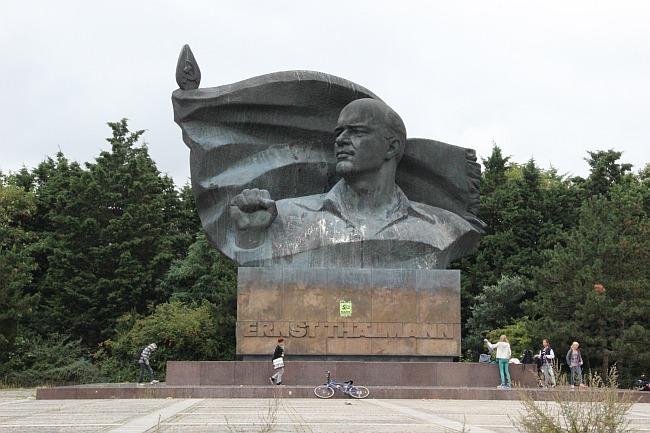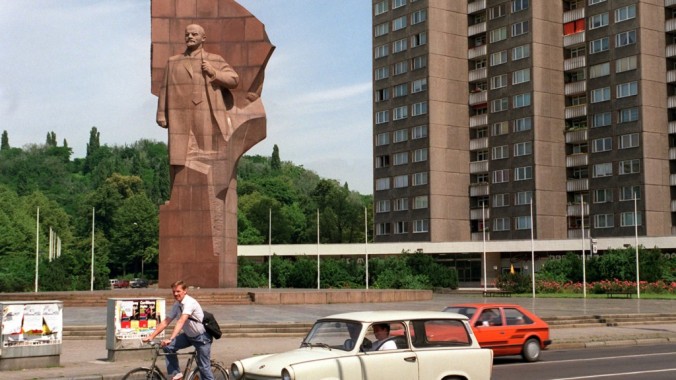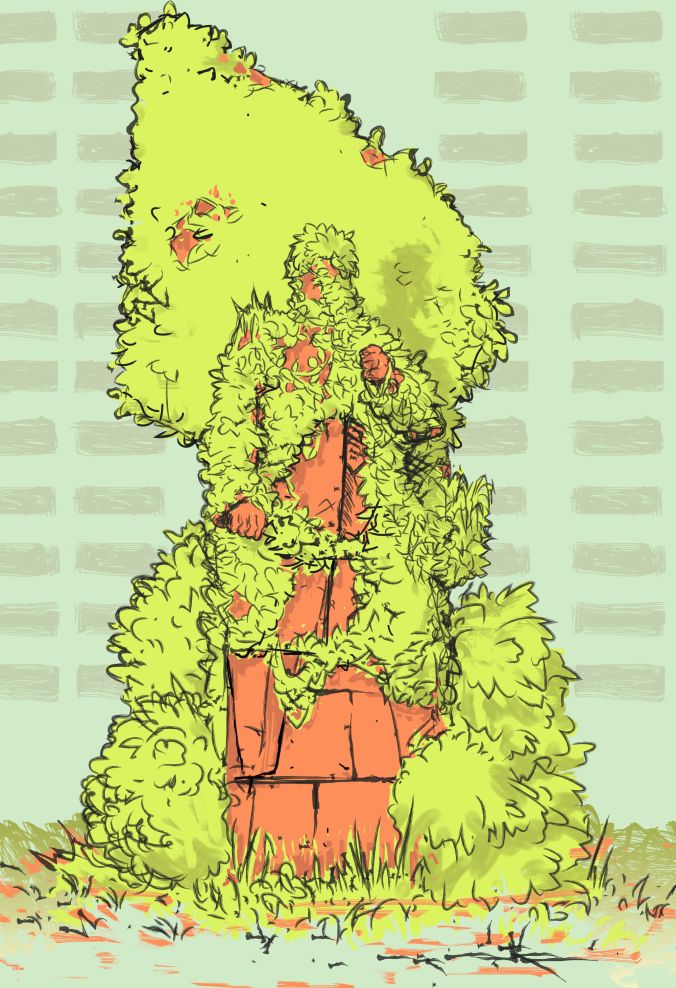When I first moved to Berlin in 2010, we had rented an apartment in Prenzlauer Berg sight unseen and it was my job to pick up the keys and take the first look. The winter that year was dragging hard into a grey and dreary March. I got off the S-Bahn at Greifswalderstraße and made my way south by foot and came across this:

Yep. Definitely the Eastern part of Berlin. At the time I thought it was Soviet revolutionary Vladimir Lenin – graffiti covered the name as it does until the city cleans it off about six times a year. I quickly discovered that this was actually Ernst Thälmann, the leader of the German Communist Party in the Weimar Era.
The massive Lenin statue that had once loomed over a square in neighbouring Friedrichshain had already been gone for 19 years at that point. In 1991, all 19 meters of red Ukrainian granite had been taken apart and buried in a forest on the outskirts of town.

In post-reunification Berlin, what monuments stayed and which had to go has not always been consistent. Why did Thälmann survive and Lenin get tossed into the dustbin of history? Yes, Thälmann has a billowing flag adorned with the hammer and sickle, but he’s been spared because of a confluence of obscurity, expense and victimhood. While Lenin was situated in the middle of square and the centerpiece of a neighbourhood, Thälmann is tucked into an unpopular park surrounded by high-rise towers in a quiet part of Prenzlauer Berg. Unless you end up on the M4 tram taking a short-cut to Alexanderplatz, you don’t see him unless you are a local. Getting rid of that much bronze and marble won’t be cheap either. Dismantling Lenin cost the city over 100,000 DM in 1991 (around €50,000) and after that there was less enthusiasm for a full sweep of old monuments even from ardent anti-communists.

Finally, Ernst Thälmann may have been a Communist but he was also a victim of the Third Reich. Arrested by the Nazis, Thälmann was executed at the Buchenwald concentration camp in 1944 after having spent 11 years in solitary confinement. Thälmann refused to work with Social Democrats to create a united front against Hitler, but he was still an opponent of fascism who died for his cause.

In some cases, the city has split the difference between Lenin’s full removal and Thälmann’s stay of execution
While there was pressure in the 1990s to wholly remove the joint Karl Marx-Friedrich Engels statue – appropriately located downtown on the Marx-Engels-Forum – opponents of the duo have had to settle for a slight relocation. Construction for an extension of the U5 U-Bahn line meant that the monument was moved to a shady corner a few hundred meters away rather than the center of the square. For the right, the bronzed pair represent the root of the East German dictatorship, but Social Democrats also trace their origins to Marx and Engels, even though the party officially renounced the cause of revolution in 1959. Although there is talk of developing the square as a whole, the statue is a favourite of tourists who love to sit in Marx’s lap or hold Engels hand for photos.
For other monuments, the city found a way to split the difference between removing a monument for being to closely associated with dictatorship, but still retaining the commemoration of anti-fascism. In Mitte, the monument to the Herbert Baum resistance groups also included the phrase “forever bound in friendship with the Soviet Union,” which is problematic regardless of one’s politics since the USSR hasn’t existed for nearly a quarter century now.

Rather than removing the monument entirely, it was instead creatively edited with plexiglass in order to obscure the praise for the Soviet Union without fully censoring the original text.

Illustration: Michal Borowski https://berlinerverlag.atavist.com/lenin
My favourite choice for how to handle the Berlin’s monuments of the past was a plan that was never actually executed. The artist Manfred Butzmann hoped to plant ivy around the Lenin monument and let nature take its course. The overgrown statue would continue to stand yet take on a whole new meaning. And it would look cool too.


I find this topic fascinating and discovering these remnants of state socialist ideology is one of my favourite pursuits when I get to the former-East. Thanks for this!
LikeLiked by 1 person
Glad you enjoyed it – also I’m a big fan of your blog!
LikeLike
Was there ever any talk of what would happen to the Soviet monument in Treptow park?
LikeLike
The Treptow monument is part of a war memorial and is actually a mass grave for over 5,000 fallen Red Army soldiers who died in the Battle of Berlin. War graves are formally under the sovereignty of the nation whose soldiers are buried there – there is complex set of international agreements and bureaucracy that controls for this. The Memorial in Treptow was originally under Soviet control which was then transferred to the Russian state in 1991.
LikeLike
Pingback: Damnatio Memoriae | Sphinx
The War Graves Cemeteries, Monuments, and (significantly) museums are the subject of a 4 + 2 Treaty which protects and finances them. The Red Army guard on the memorial by the Brandenburger Tor, in the British Sector, was withdrawn, of course. I always felt that the Pankow Cemetery was more moving than that at Treptow.
The Russian museum remains in Karlshorst where the Soviet Berlin Garrison was centred, and an Allied Museum was established on Clayallee, in the former US Cinema & Nicholson Memorial Library, both funded to some extent by the German tax payer. The Nicholson Library makes a point – Major Nicholson was an officer with the US Mission to the Soviet C-in-C who was shot by a Red Army sentry, and then left to bleed to death. He was promoted Lt Col posthumously, which, presumably, improved the widow’s pension?
LikeLike
They actually dug up the head of the Lenin statue and have it on display in the Zitadelle Spandau by now.
LikeLike
Lovely poost
LikeLike